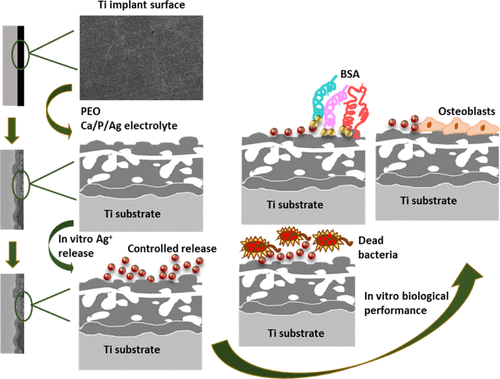当前位置:
X-MOL 学术
›
ACS Appl. Mater. Interfaces
›
论文详情
Our official English website, www.x-mol.net, welcomes your
feedback! (Note: you will need to create a separate account there.)
Fabrication of Microporous Coatings on Titanium Implants with Improved Mechanical, Antibacterial, and Cell-Interactive Properties.
ACS Applied Materials & Interfaces ( IF 8.3 ) Pub Date : 2020-06-12 , DOI: 10.1021/acsami.0c07234 Monica Thukkaram 1 , Renee Coryn 1 , Mahtab Asadian 1 , Parinaz Saadat Esbah Tabaei 1 , Petra Rigole 2 , Naveenkumar Rajendhran 3 , Anton Nikiforov 1 , Jacob Sukumaran 3 , Tom Coenye 2 , Pascal Van Der Voort 4 , Gijs Du Laing 5 , Rino Morent 1 , Alexander Van Tongel 6 , Lieven De Wilde 6 , Patrick De Baets 3 , Kim Verbeken 7 , Nathalie De Geyter 1
ACS Applied Materials & Interfaces ( IF 8.3 ) Pub Date : 2020-06-12 , DOI: 10.1021/acsami.0c07234 Monica Thukkaram 1 , Renee Coryn 1 , Mahtab Asadian 1 , Parinaz Saadat Esbah Tabaei 1 , Petra Rigole 2 , Naveenkumar Rajendhran 3 , Anton Nikiforov 1 , Jacob Sukumaran 3 , Tom Coenye 2 , Pascal Van Der Voort 4 , Gijs Du Laing 5 , Rino Morent 1 , Alexander Van Tongel 6 , Lieven De Wilde 6 , Patrick De Baets 3 , Kim Verbeken 7 , Nathalie De Geyter 1
Affiliation

|
The success of an orthopedic implant therapy depends on successful bone integration and the prevention of microbial infections. In this work, plasma electrolytic oxidation (PEO) was performed to deposit TiO2 coatings enriched with Ca, P, and Ag on titanium to improve its surface properties and antibacterial efficacy while maintaining normal biological functions and thus to enhance the performance of orthopedic implants. After PEO treatment, the surface of Ti was converted to anatase and rutile TiO2, hydroxyapatite, and calcium titanate phases. The presence of these crystalline phases was further increased with an increased Ag content in the coatings. The developed coatings also exhibited a more porous morphology with an improved surface wettability, roughness, microhardness, and frictional coefficient. In vitro antibacterial assays indicated that the Ag-doped coatings can significantly prevent the growth of both Staphylococcus aureus and Escherichia coli by releasing Ag+ ions, and the ability to prevent these bacteria was enhanced by increasing the Ag content in the coatings, resulting in a maximal 6-log reduction of E. coli and a maximal 5-log reduction of S. aureus after 24 h of incubation. Moreover, the in vitro cytocompatibility evaluation of the coatings showed that the osteoblast (MC3T3) cell integration on the PEO-based coatings was greatly improved compared to untreated Ti and no notable impact on their cytocompatibility was observed on increasing the amount of Ag in the coating. In conclusion, the coating with favorable physicochemical and mechanical properties along with controlled silver ion release can offer an excellent antibacterial performance and osteocompatibility and can thus become a prospective coating strategy to face current challenges in orthopedics.
中文翻译:

具有改善的机械,抗菌和细胞相互作用特性的钛植入物上微孔涂层的制备。
骨科植入物疗法的成功取决于成功的骨整合和预防微生物感染。在这项工作中,进行了等离子体电解氧化(PEO),以在钛上沉积富含Ca,P和Ag的TiO 2涂层,以改善其表面性能和抗菌功效,同时保持正常的生物学功能,从而增强整形外科植入物的性能。经过PEO处理后,Ti的表面转化为锐钛矿和金红石型TiO 2,羟基磷灰石和钛酸钙相。这些结晶相的存在随着涂层中Ag含量的增加而进一步增加。所开发的涂层还表现出更多孔的形态,具有改善的表面润湿性,粗糙度,显微硬度和摩擦系数。体外抗菌试验表明,掺杂银的涂层可以通过释放Ag +离子来显着阻止金黄色葡萄球菌和大肠杆菌的生长,并且通过增加涂层中的Ag含量来增强预防这些细菌的能力,从而导致的最大6个对数减少的大肠杆菌和的最大5-log减少金黄色葡萄球菌孵育24小时后。此外,涂层的体外细胞相容性评估表明,与未处理的Ti相比,PEO基涂层上的成骨细胞(MC3T3)细胞整合得到了极大的改善,并且在增加涂层中Ag的量方面,未观察到对其细胞相容性的显着影响。总之,具有良好的物理化学和机械性能以及受控的银离子释放的涂层可以提供出色的抗菌性能和骨相容性,因此可以成为面对骨科当前挑战的前瞻性涂层策略。
更新日期:2020-07-08
中文翻译:

具有改善的机械,抗菌和细胞相互作用特性的钛植入物上微孔涂层的制备。
骨科植入物疗法的成功取决于成功的骨整合和预防微生物感染。在这项工作中,进行了等离子体电解氧化(PEO),以在钛上沉积富含Ca,P和Ag的TiO 2涂层,以改善其表面性能和抗菌功效,同时保持正常的生物学功能,从而增强整形外科植入物的性能。经过PEO处理后,Ti的表面转化为锐钛矿和金红石型TiO 2,羟基磷灰石和钛酸钙相。这些结晶相的存在随着涂层中Ag含量的增加而进一步增加。所开发的涂层还表现出更多孔的形态,具有改善的表面润湿性,粗糙度,显微硬度和摩擦系数。体外抗菌试验表明,掺杂银的涂层可以通过释放Ag +离子来显着阻止金黄色葡萄球菌和大肠杆菌的生长,并且通过增加涂层中的Ag含量来增强预防这些细菌的能力,从而导致的最大6个对数减少的大肠杆菌和的最大5-log减少金黄色葡萄球菌孵育24小时后。此外,涂层的体外细胞相容性评估表明,与未处理的Ti相比,PEO基涂层上的成骨细胞(MC3T3)细胞整合得到了极大的改善,并且在增加涂层中Ag的量方面,未观察到对其细胞相容性的显着影响。总之,具有良好的物理化学和机械性能以及受控的银离子释放的涂层可以提供出色的抗菌性能和骨相容性,因此可以成为面对骨科当前挑战的前瞻性涂层策略。











































 京公网安备 11010802027423号
京公网安备 11010802027423号